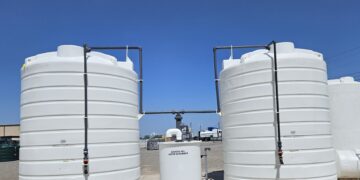The safe storage and handling of hydrochloric acid tanks are crucial for both operational efficiency and environmental safety. This article delves into the essential characteristics, materials, and storage requirements for hydrochloric acid tanks.
The Role of Hydrochloric Acid in Industry:
Hydrochloric acid is one of the most widely used acids in industrial applications. It serves multiple purposes, such as adjusting pH levels in water treatment processes, refining metals, and manufacturing organic compounds like vinyl chloride, essential for producing PVC
However, due to its highly corrosive properties, storing HCl requires specialized tanks designed to withstand its aggressive effects
Types of Hydrochloric Acid Tanks:
The construction of hydrochloric acid tanks primarily utilizes materials such as high-density polyethylene (HDPE), fiberglass-reinforced plastic (FRP), and rubber-lined steel. HDPE tanks are popular due to their cost-effectiveness and excellent chemical resistance, making them suitable for most hydrochloric acid storage needs. For larger quantities, FRP tanks provide durability and resistance to corrosive vapors
Rubber-lined steel tanks are recommended for substantial storage volumes, often exceeding 15,000 gallons, as they offer robust structural integrity, though they come with higher installation and maintenance costs
Polypropylene tanks are also utilized for smaller quantities of diluted hydrochloric acid but are less common due to their limitations with higher concentrations
Storage Requirements and Safety Precautions:
When it comes to hydrochloric acid tanks, specific safety measures must be observed to prevent accidents and ensure safe handling. Storage systems should include features like fume vents and scrubbers to manage vapors effectively, as HCl can produce harmful fumes
Additionally, it is imperative to keep tanks away from heat sources and incompatible materials, using airtight connections to minimize the risk of leaks
Regular inspections and maintenance are crucial for ensuring the integrity of the storage system. For example, the fittings, gaskets, and structural support should be made from materials resistant to HCl, such as PVC and Hastelloy, to prevent degradation over time
Furthermore, tanks must be equipped with proper ventilation to manage pressure and prevent hazardous buildup
Conclusion:
Hydrochloric acid tanks play a pivotal role in various industrial processes, necessitating careful design, construction, and maintenance to ensure safety and efficacy. By employing materials that resist the corrosive nature of HCl and adhering to stringent storage protocols, industries can effectively manage this essential chemical while safeguarding both personnel and the environment. As the demand for hydrochloric acid continues to grow, so does the importance of reliable and secure storage solutions that comply with safety regulations.




















































